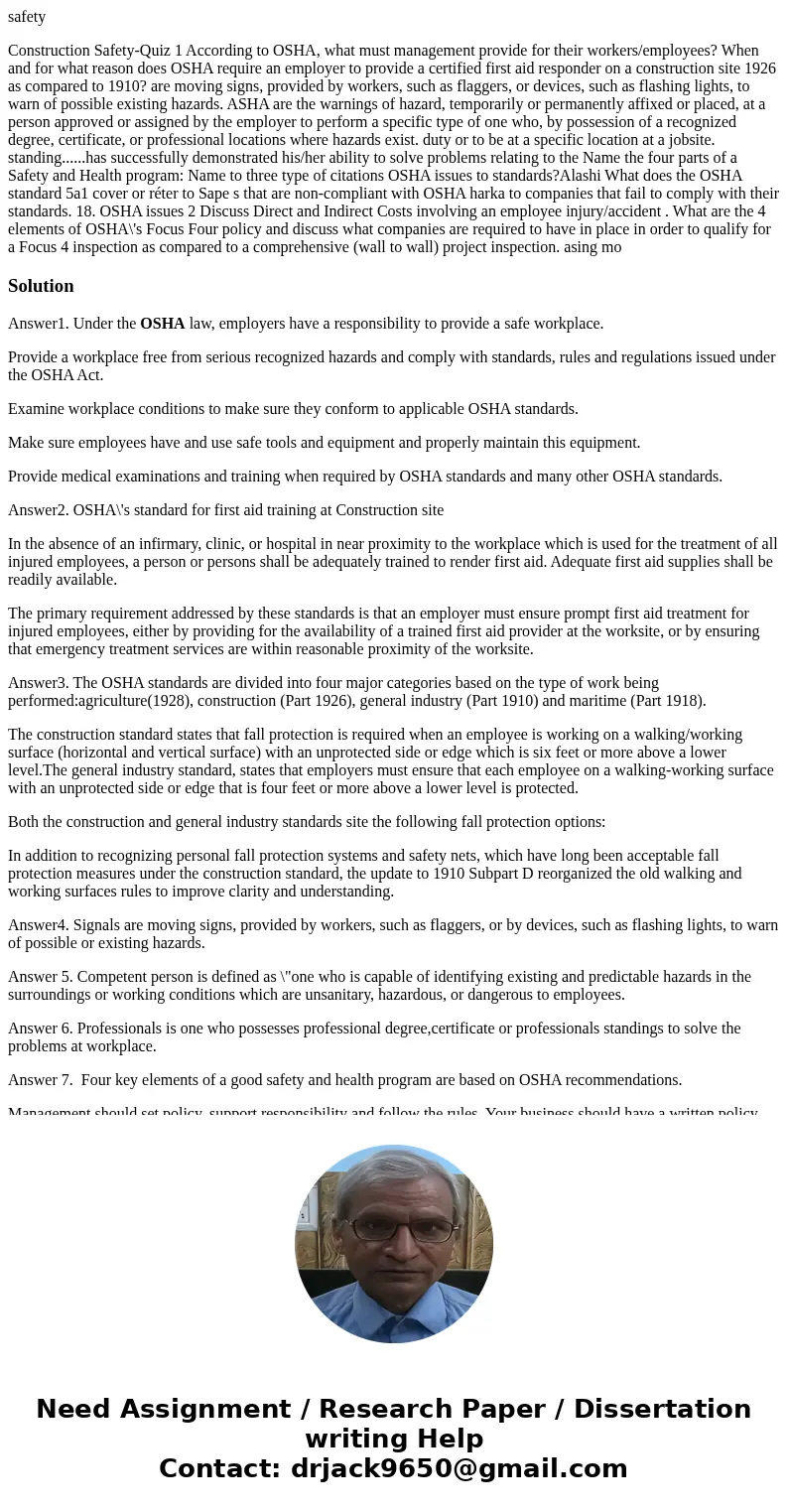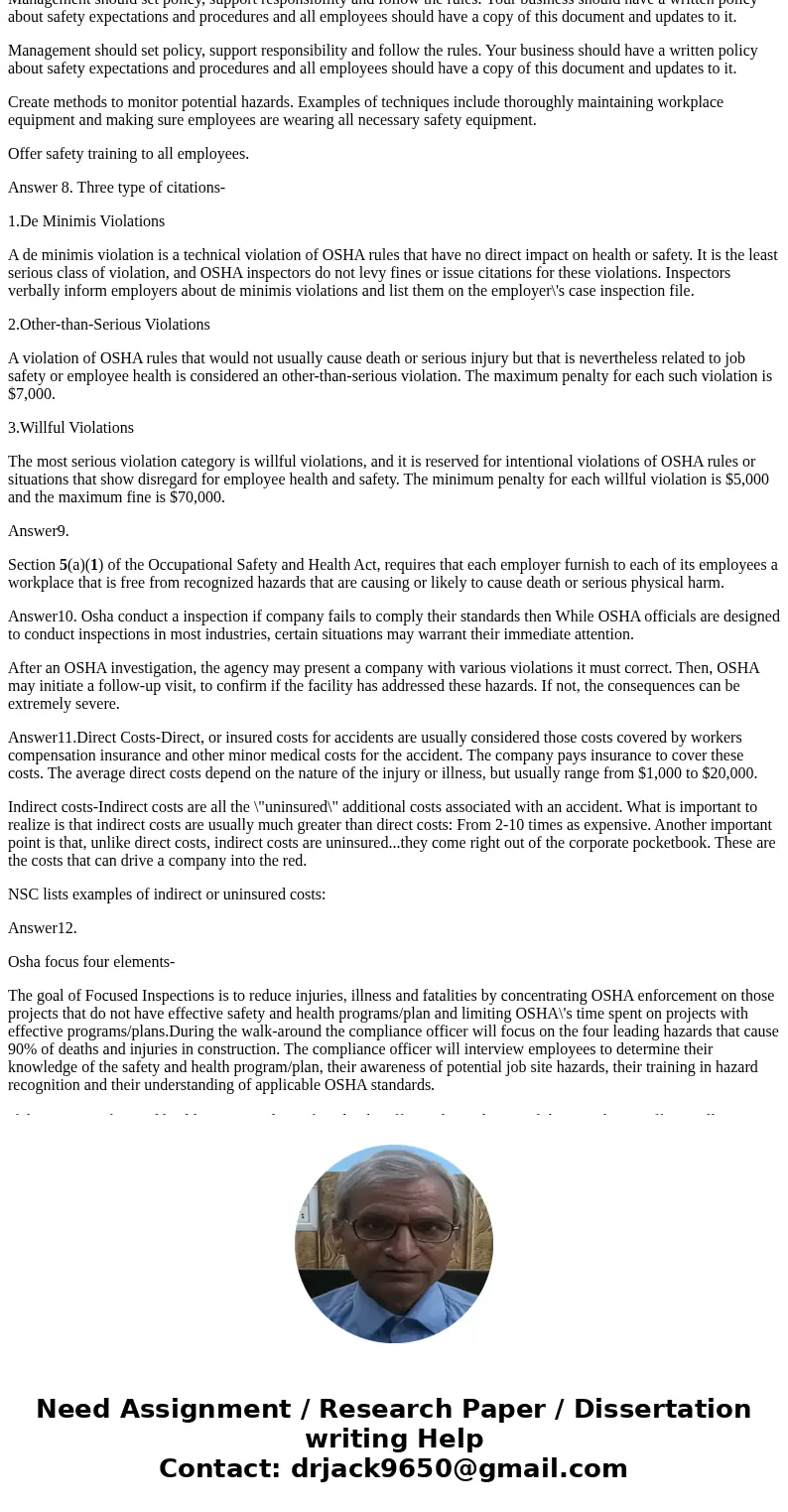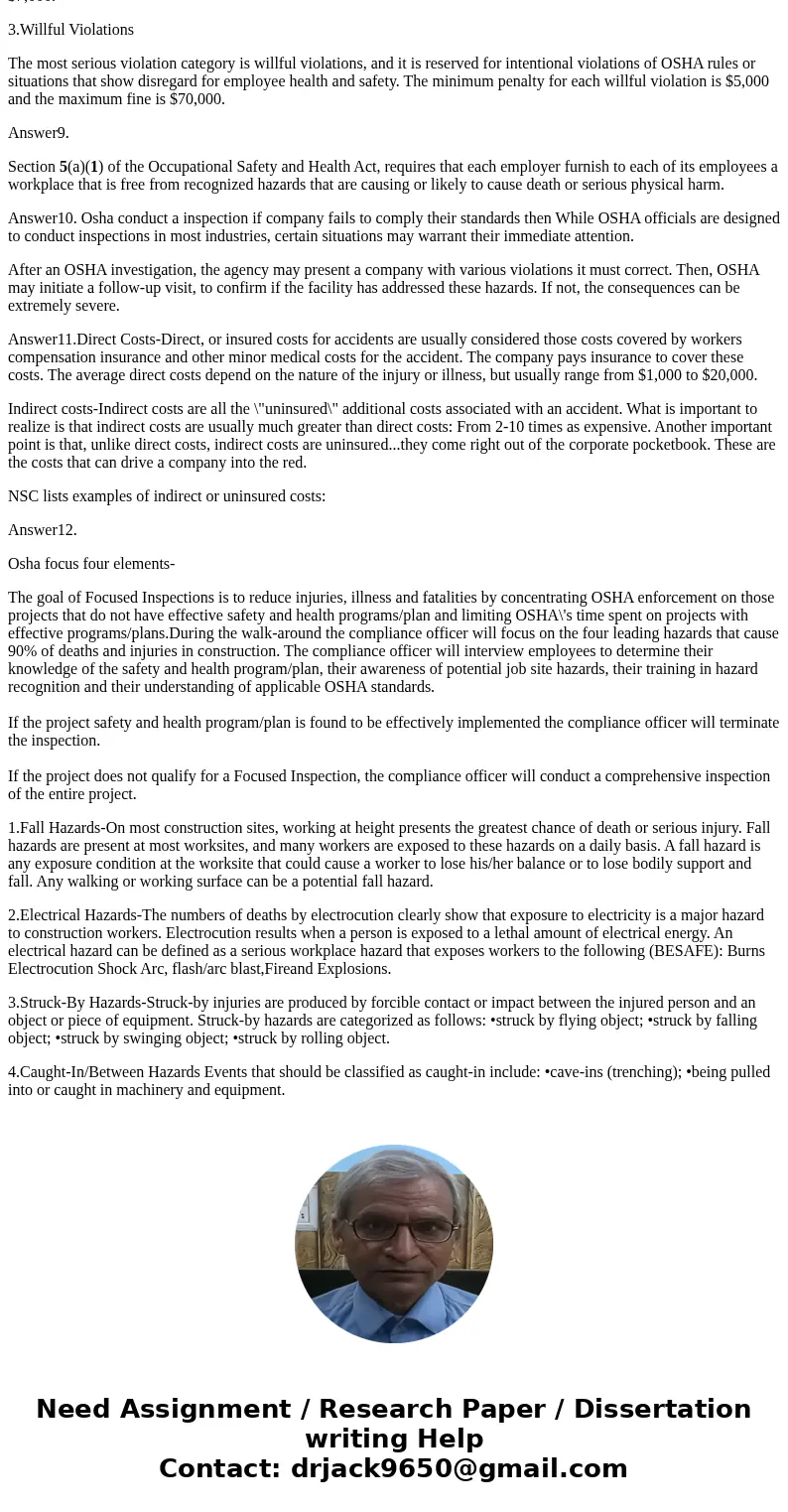safety Construction SafetyQuiz 1 According to OSHA what must
safety
Construction Safety-Quiz 1 According to OSHA, what must management provide for their workers/employees? When and for what reason does OSHA require an employer to provide a certified first aid responder on a construction site 1926 as compared to 1910? are moving signs, provided by workers, such as flaggers, or devices, such as flashing lights, to warn of possible existing hazards. ASHA are the warnings of hazard, temporarily or permanently affixed or placed, at a person approved or assigned by the employer to perform a specific type of one who, by possession of a recognized degree, certificate, or professional locations where hazards exist. duty or to be at a specific location at a jobsite. standing......has successfully demonstrated his/her ability to solve problems relating to the Name the four parts of a Safety and Health program: Name to three type of citations OSHA issues to standards?Alashi What does the OSHA standard 5a1 cover or réter to Sape s that are non-compliant with OSHA harka to companies that fail to comply with their standards. 18. OSHA issues 2 Discuss Direct and Indirect Costs involving an employee injury/accident . What are the 4 elements of OSHA\'s Focus Four policy and discuss what companies are required to have in place in order to qualify for a Focus 4 inspection as compared to a comprehensive (wall to wall) project inspection. asing moSolution
Answer1. Under the OSHA law, employers have a responsibility to provide a safe workplace.
Provide a workplace free from serious recognized hazards and comply with standards, rules and regulations issued under the OSHA Act.
Examine workplace conditions to make sure they conform to applicable OSHA standards.
Make sure employees have and use safe tools and equipment and properly maintain this equipment.
Provide medical examinations and training when required by OSHA standards and many other OSHA standards.
Answer2. OSHA\'s standard for first aid training at Construction site
In the absence of an infirmary, clinic, or hospital in near proximity to the workplace which is used for the treatment of all injured employees, a person or persons shall be adequately trained to render first aid. Adequate first aid supplies shall be readily available.
The primary requirement addressed by these standards is that an employer must ensure prompt first aid treatment for injured employees, either by providing for the availability of a trained first aid provider at the worksite, or by ensuring that emergency treatment services are within reasonable proximity of the worksite.
Answer3. The OSHA standards are divided into four major categories based on the type of work being performed:agriculture(1928), construction (Part 1926), general industry (Part 1910) and maritime (Part 1918).
The construction standard states that fall protection is required when an employee is working on a walking/working surface (horizontal and vertical surface) with an unprotected side or edge which is six feet or more above a lower level.The general industry standard, states that employers must ensure that each employee on a walking-working surface with an unprotected side or edge that is four feet or more above a lower level is protected.
Both the construction and general industry standards site the following fall protection options:
In addition to recognizing personal fall protection systems and safety nets, which have long been acceptable fall protection measures under the construction standard, the update to 1910 Subpart D reorganized the old walking and working surfaces rules to improve clarity and understanding.
Answer4. Signals are moving signs, provided by workers, such as flaggers, or by devices, such as flashing lights, to warn of possible or existing hazards.
Answer 5. Competent person is defined as \"one who is capable of identifying existing and predictable hazards in the surroundings or working conditions which are unsanitary, hazardous, or dangerous to employees.
Answer 6. Professionals is one who possesses professional degree,certificate or professionals standings to solve the problems at workplace.
Answer 7. Four key elements of a good safety and health program are based on OSHA recommendations.
Management should set policy, support responsibility and follow the rules. Your business should have a written policy about safety expectations and procedures and all employees should have a copy of this document and updates to it.
Management should set policy, support responsibility and follow the rules. Your business should have a written policy about safety expectations and procedures and all employees should have a copy of this document and updates to it.
Create methods to monitor potential hazards. Examples of techniques include thoroughly maintaining workplace equipment and making sure employees are wearing all necessary safety equipment.
Offer safety training to all employees.
Answer 8. Three type of citations-
1.De Minimis Violations
A de minimis violation is a technical violation of OSHA rules that have no direct impact on health or safety. It is the least serious class of violation, and OSHA inspectors do not levy fines or issue citations for these violations. Inspectors verbally inform employers about de minimis violations and list them on the employer\'s case inspection file.
2.Other-than-Serious Violations
A violation of OSHA rules that would not usually cause death or serious injury but that is nevertheless related to job safety or employee health is considered an other-than-serious violation. The maximum penalty for each such violation is $7,000.
3.Willful Violations
The most serious violation category is willful violations, and it is reserved for intentional violations of OSHA rules or situations that show disregard for employee health and safety. The minimum penalty for each willful violation is $5,000 and the maximum fine is $70,000.
Answer9.
Section 5(a)(1) of the Occupational Safety and Health Act, requires that each employer furnish to each of its employees a workplace that is free from recognized hazards that are causing or likely to cause death or serious physical harm.
Answer10. Osha conduct a inspection if company fails to comply their standards then While OSHA officials are designed to conduct inspections in most industries, certain situations may warrant their immediate attention.
After an OSHA investigation, the agency may present a company with various violations it must correct. Then, OSHA may initiate a follow-up visit, to confirm if the facility has addressed these hazards. If not, the consequences can be extremely severe.
Answer11.Direct Costs-Direct, or insured costs for accidents are usually considered those costs covered by workers compensation insurance and other minor medical costs for the accident. The company pays insurance to cover these costs. The average direct costs depend on the nature of the injury or illness, but usually range from $1,000 to $20,000.
Indirect costs-Indirect costs are all the \"uninsured\" additional costs associated with an accident. What is important to realize is that indirect costs are usually much greater than direct costs: From 2-10 times as expensive. Another important point is that, unlike direct costs, indirect costs are uninsured...they come right out of the corporate pocketbook. These are the costs that can drive a company into the red.
NSC lists examples of indirect or uninsured costs:
Answer12.
Osha focus four elements-
The goal of Focused Inspections is to reduce injuries, illness and fatalities by concentrating OSHA enforcement on those projects that do not have effective safety and health programs/plan and limiting OSHA\'s time spent on projects with effective programs/plans.During the walk-around the compliance officer will focus on the four leading hazards that cause 90% of deaths and injuries in construction. The compliance officer will interview employees to determine their knowledge of the safety and health program/plan, their awareness of potential job site hazards, their training in hazard recognition and their understanding of applicable OSHA standards.
If the project safety and health program/plan is found to be effectively implemented the compliance officer will terminate the inspection.
If the project does not qualify for a Focused Inspection, the compliance officer will conduct a comprehensive inspection of the entire project.
1.Fall Hazards-On most construction sites, working at height presents the greatest chance of death or serious injury. Fall hazards are present at most worksites, and many workers are exposed to these hazards on a daily basis. A fall hazard is any exposure condition at the worksite that could cause a worker to lose his/her balance or to lose bodily support and fall. Any walking or working surface can be a potential fall hazard.
2.Electrical Hazards-The numbers of deaths by electrocution clearly show that exposure to electricity is a major hazard to construction workers. Electrocution results when a person is exposed to a lethal amount of electrical energy. An electrical hazard can be defined as a serious workplace hazard that exposes workers to the following (BESAFE): Burns Electrocution Shock Arc, flash/arc blast,Fireand Explosions.
3.Struck-By Hazards-Struck-by injuries are produced by forcible contact or impact between the injured person and an object or piece of equipment. Struck-by hazards are categorized as follows: •struck by flying object; •struck by falling object; •struck by swinging object; •struck by rolling object.
4.Caught-In/Between Hazards Events that should be classified as caught-in include: •cave-ins (trenching); •being pulled into or caught in machinery and equipment.



 Homework Sourse
Homework Sourse